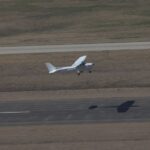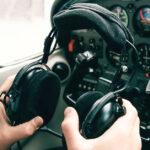Ask a student pilot what skills are needed to be a pilot and he might say steep turns, stalls, and landings. Ask a commercial pilot and he may say chandelles, lazy eights, and accuracy landings. However, once the ink is dry on the newly won certificate, what are the true skills needed to be a pilot in the real world? There are many, but we will look at three of the most important.
First and foremost is to have a pilot-in-command mentality.
The second would be to develop a constant sense of situational awareness.
The third would be to have a deep and growing understanding of weather and its related systems.
Developing a pilot-in-command mentality
While in the training environment, there is almost always an instructor handy to answer questions, give direction, and explain what needs to be done. When operating as the PIC, it’s all up to you. While there are many forms of help available, such as ATC, Flight Watch, emergency checklists, etc., you are the one who is flying the airplane and you must be the one who makes the decisions. You cannot pass that responsibility to anyone else. You will need to know what information is needed and how to analyze that information to make the best decisions. These decisions run the gamut and include: changing weather conditions and what it means for your route of flight; troubleshooting aircraft problems that arise to determine if you can continue to your destination or need to make a precautionary landing; dealing with unexpected ATC changes to clearances; and a host of other issues.
Hopefully, you were taught during your flight training to always be playing the “what if” game. When you are not in a heavy workload situation, you should be sharpening your PIC skills by asking yourself what you would do if, for example, the low voltage light comes on, if the engine starts to run rough, if the ceiling starts to lower, if I suddenly fell ill, and a myriad of other questions. By practicing this drill, you will be more prepared to handle actual situations when they arise.
Another situation a PIC needs to understand is that there may be times when you need to question ATC instructions and even use the term “unable” when the situation demands. Such situations may come about if vectors or assigned altitudes would put you into thunderstorms or icing conditions. Other conditions may arise if an ATC delay would put you in a position of inadequate fuel reserves. The point is that you do not blindly follow instructions that could put your flight in jeopardy. As PIC, you have every right to question, and when necessary, reject an ATC instruction.
Developing a constant sense of situational awareness
With all the wonderful help that technically advanced aircraft provide, they can also lull the pilot into unwittingly turning over PIC responsibilities to aircraft automation as he blindly follows the blue line wherever it takes him. The need for situational awareness does not lessen because of automation.
The situationally aware pilot should always be asking himself three questions. Where am I? What am I waiting for? What will I do when that happens? This is how the pilot stays ahead of the airplane. For example, knowing that you are getting close to the airport but are still high will prompt you to request lower if IFR, or start your descent if VFR, and to prevent arriving at the runway high and fast. Knowing that you are getting close to the course you are intercepting allows you to begin the turn on time, preventing overshooting the course and having to correct back. Tracking the distance to your destination and computing fuel burn prevents arriving with inadequate fuel reserves.
Technically advanced aircraft are a great aid in staying situationally aware, but it is up to the pilot to stay focused rather than letting the airplane do his thinking for him. Ask yourself, is automation serving me, or am I serving it?
Developing a deep and growing understanding of weather and its related systems
We all know by education, if not by our own experience, that weather is the most changing variable on any flight. There is a great deal of weather data available to a pilot, both during pre-flight planning and during the flight itself. It is incumbent on the pilot to determine what information is needed and how to interpret the information provided by the various weather products. You will need to start with an overall understanding of the weather systems along the route of flight and how those systems are affecting your weather. You will then need to understand and interpret weather forecasts and actual weather reports and know each of their strengths and weaknesses. You also will need to have a healthy skepticism of forecasts, especially in a changing weather environment.
One of the best ways to evaluate if the forecast is likely to be accurate is to look at the trend of the actual weather reports. Trends are often more important than the actual weather. A 1000 foot ceiling that is decreasing is an entirely different situation than a 1000 foot ceiling that is lifting. By looking at these trends you can see if they are supporting the forecast or if they are proving it to be unreliable.
One other important fact every pilot should know before setting off on a cross-country flight is, in which direction does better weather lie? If a deviation becomes necessary, knowing which way to look is essential in being well prepared.
The fact is, you are the PIC, and you need to make wise weather decisions. The pilot who turns that responsibility over to a weather briefer (most likely not a pilot) will be ill-prepared to deal with the changing weather environment.










